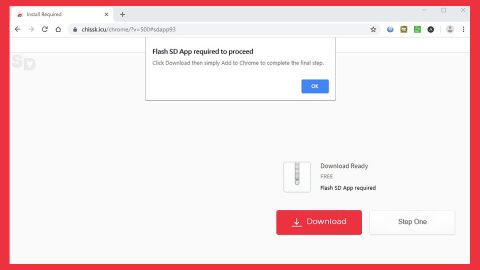What to know about BlackSheep Ransomware
BlackSheep Ransomware is a kind of virus, a Cryptovirus variant to be specific that shows a fake Windows Update screen on the users system, while it encrypts your files in the background of the process. Basically, it is indeed a file encrypting malware showing a blue screen windows as it initiates on your system, so when you notice your screen turns blue during the process, no doubt it is infected with BlackSheep. What happens is that, while the system users are waiting for the process to be completed, at the same time the malware encrypts all your files without your knowledge. Once it successfully encrypts your files, it appends “.666” file extension at the end of the every encoded files.

Once updates are installed on your computer system, then all your data and files are at risk and may become corrupted and then this very ransom virus shows a scary lock screen ransom note on your desktop noting you to pay the amount of ransom money in order for you to decrypt all your files that are infected. The note basically contains lots of mistakes. The attackers ask you to pay amount of $500 in Bitcoins within 54 hours of given time interval in return to decrypt your files. Luckily, there’s a way to decrypt the locked files, and that is by using SpyRemover Pro for your data recovery for free. So there is no need to follow and give in to the cyber criminals orders and waste your valuable money.
How does BlackSheep Ransomware get into the computer?
Like any other mlaware or virus silently, most of the ransomware got access to into the users system silently as well and infect them to easily carryout their vicious kind of works. The makers of this BlackSheep Ransomware uses many of infection spreading route and techniques to attack on a large number of computer systems. Most of this kind of file encrypting malware, well more often than not, most malware rely on the same method of infections such as via spam email attachments, malicious advertisements, suspicious downloads and uses of fake updates, infected JavaScript codes injection into an embedded doc files and pirated software downloads and so on and so forth. So all you have to do is to apply some of the preventive measures and precautions to stay protected from this kind of malware attacks. Also an important move is to invest into anti-malware to remove BlackSheep Ransomware from your system and then after run the backup files to restore the lost documents.
What to do if your computer get infected by BlackSheep Ransomware?
The ransomware infection has been mainly developed intentionally to scare users and trick them to pay so they earn money. Basically, it take your files on hostage and demand ransom to return your important data to be unlocked or decrypted. But now that you are infected with the ransomware, what you can do when your system got infected by BlackSheep Ransomware virus? Below are some options that you can use to eradicate this nasty infection.
Don’t Panic – Well the first thing is Don’t panic and then completely check out your system for any working files. If you got any working files then copy or transfer it to USB drive, and then try to think what to do next.
Pay Ransom – Other option is you can pay the ransom and wait to get your files back, but it’s not necessary since there is no assurance you get back all your files decrypted once you pay the ransome.
Use Backup – It is also essential to clean your entire system files, remove the infection completely from your PC and restore your files with any backup.
Remove Infection – The best way to stop the ransom act is to delete BlackSheep Ransomware virus using malware removal tool and remove all the infected files. You can later recover all your data by using any data recovery tool.
Reinstall Windows – The last option you have to do is reinstall your Windows OS. Reinstalling it will completely remove all your data as well as infection. You will get a completely new virus/malware-free computer.
How To Remove BlackSheep Ransomware Virus From Your PC
Step 1 – Boot your computer in Safe mode.
Reboot in Safe Mode for All Versions:
How to Boot Windows in Safe Mode to isolate Malware
For Windows XP, Vista and Win 7
- Restart your PC using the Start Menu after removing all CDs and DVDs
- Press F8 repeatedly until boot screen does not shows up on the screen. In case if you have missed it, repeat the same step again.
3. Now Select the Safe Mode option using the Arrow keys as soon as Advanced Boot Options appear on the Screen.

4. Now Once the Selection is made, Press Enter
For Windows 8 and 8.1
Press on Start button, then Select Control Panel
Now Choose System and Security —> Administrative Tools —> System Configuration.


Now Select on Safe Mode from the list and Click on OK.
Windows 10
Step 1: Click on the Start Menu
Step 2: Hold down Shift Button, Click on Power and then press on Restart button
Step 3: Now Choose Troubleshoot >> Advanced Option >> Startup Settings
Step 4: Now Click on Restart Option
you need to Select on Safe Mode to Restart your Windows Computer.
Step 2 – Remove the infected registry entry files.
- Click Windows Flag and R button together.
- Type “regedit” and click OK button
- Find and delete following entries.
HKEY_LOCAL_MACHINESOFTWAREsupWPM
HKEY_LOCAL_MACHINESYSTEMCurrentControlSetServicesWpm
HKEY_CURRENT_USERSoftwareMicrosoftInternet ExplorerMain “Default_Page_URL”
HKEY_LOCAL_Machine\Software\Classes\[BlackSheep Ransomware]
HKEY_CURRENT_USER\Software\Microsoft\Windows\CurrentVersion\Uninstall\[BlackSheep Ransomware]
Step 3 – Remove From msconfig
- Click Windows + R buttons simultaneously.
- Type msconfig and press Enter
- Go to Startup tab and uncheck all entries from unknown manufacturer.
Step 4 – Restart your computer normally.
Check your computer now. If the virus has gone then you can start using your computer. If the infection still remains then head to the next step.
Step 5 – System Restore
- Insert Windows installation disk to CD drive and restart your PC.
- While system startup, keep pressing F8 or F12 key to get boot options.
- Now select the boot from CD drive option to start your computer.
- Then after you will get the System Recovery Option on your screen.
- Select the System Restore option from the list.
- Choose a nearest system restore point when your PC was not infected.
- Now follow the option on your screen to Restore your computer.
If the above manual methods didn’t removed BlackSheep Ransomware virus then you have only option to remove infection using a malware removal tool. It is last and the only option that can easily and safely remove this nasty threat from your computer.
Use an anti-malware program
We recommend using SpyRemover Pro, a highly effective and widely used malware removal program to clean your computer of BlackSheep Ransomware. In addition to BlackSheep Ransomware, this program can detect and remove the latest variants of other malware.
SpyRemover Pro has an intuitive user interface that is easy to use. To get rid of BlackSheep Ransomware, the first step is to install it, scan your computer, and remove the threat.
To remove BlackSheep Ransomware from your computer using SpyRemover Pro, you need to perform the following steps:

Basic steps of SpyRemover Pro:
Step 1. Run SpyRemover Pro installer
Click on the .exe file that just downloaded in the lower right corner of your browser window.
Step 2. Click Yes
Click Yes to accept the User Account Control settings dialog.
Step 3. Foll0w setup instructions
Follow the instructions to get SpyRemover Pro set up on your computer and you will be good to go!















